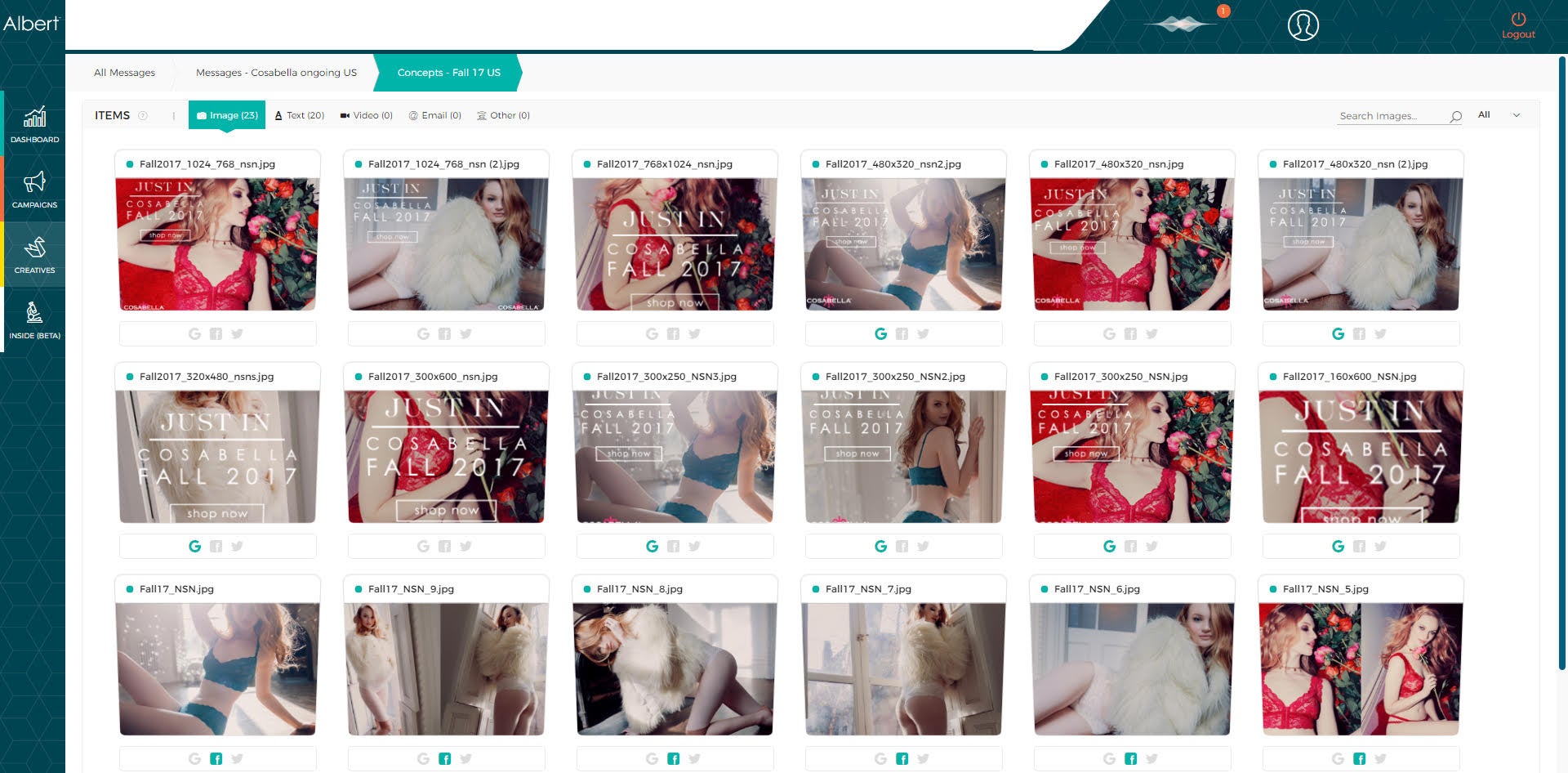Why Fashion Brand Cosabella Let a Robot Take Control of Its Marketing Budget To keep up in the world of ecommerce startups, Cosabella replaced human guesswork with computer analysis.
Opinions expressed by Entrepreneur contributors are their own.

In this series, The Fix, Entrepreneur Associate Editor Lydia Belanger shares her conversations with founders and executives whose solutions to inefficiencies can inspire others to find new ways to save themselves time, money or hassle.
Lingerie brand Cosabella has long experimented with up-and-coming technologies to get the word out about its products. When online message boards became popular in the "90s, founder Valeria Campello created the username "NoMoreVPL" and anonymously conversed with women, praising Cosabella's thong underwear for its ability to eliminate visible panty lines. Her efforts paid off: Celebrities such as Angelina Jolie, Gwyneth Paltrow and Winona Ryder were soon wearing them.
Today, Cosabella is after the next tech-driven revelations. The 34-year-old company, which previously focused on manufacturing and wholesale, is now investing heavily in direct-to-consumer retailing and marketing. CEO Guido Campello, Valeria's son, says the brand's goal is to "look just as sexy, just as lucrative and just as "startup'" as the latest, buzzy players in women's fashion. To do so, Cosabella had to find a way to adapt its digital marketing strategy -- and quickly.
Related: The Family Behind Luxury Lingerie Business Cosabella
"When it came to ad spend, which is one of the most basic principles of building customer lifetime value and driving customers, we needed something that could do that for us in a very efficient manner, do it based on its success and know that its success was efficient," says Campello, adding the company was sick of spending money on agency-driven ad campaigns that weren't able to objectively measure results.
Cosabella realized it needed a computer, not humans, to tell it how to look, what to say and where to put its dollars.
The fix
The Cosabella team had been to a handful of retail and ecommerce conferences where artificial intelligence (AI) had been a hot topic. They heard about how smaller brands were beginning to use AI for consumer targeting to keep up with massive online retailers such as Amazon.
So after hearing about Albert, an artificial intelligence marketing platform that works across all channels, including search, mobile, social and display, they decided to give it a shot.
By implementing Albert, Cosabella's in-house content creation team is able to quickly test ads and immediately swap them out or make edits to them if they're not getting people's attention. Employees could now test multiple pieces of content at a time, across different channels or even different countries, then present the results in an organized way that's easy for humans to digest visually. That way, people who create ad campaigns or even products can spend their time creating, not analyzing.
"We're able to say, look, this worked well, let's go ahead and run it for five more days or six more days, or, let's give it a subcategory or focus it," Campello says. "There's so much that you can test on how you're getting your message across. It's really A/B testing for marketing but to the minute."
More importantly, Albert doesn't just tell Cosabella what's working. It makes thousands of decisions a day -- everything from email newsletters to search engine optimization -- without consulting any human at the company. This might mean Albert halts one digital campaign and throws money at another. The human team, meanwhile, is able to monitor Albert and make adjustments if desired.
Campello also emphasizes that, contrary to what some might expect, the AI platform wasn't too time-consuming to implement or too technical for Cosabella's existing employees to manage.
"I didn't need, you know, 150 hours of training, where the team had to sit in a room with a consultant and then have so many calls. It was very fluid and easy," Campello says. "It's really something that, if it was affordable enough, and you were selling jam out of your kitchen, you would want to use it and you could use it. You literally could find the ability to apply it and still do everything else you do during the day."
Campello says Cosabella is spending about the same amount of money on Albert as it used to pay the digital ad agency Albert replaced -- and getting a lot more for its money.
The results
Cosabella quantifies Albert's effectiveness in terms of return on ad spend (ROAS). In the company's first month using the platform, Albert increased Cosabella's ROAS for social media and search by 50 percent while decreasing the total amount spent on ads by 12 percent during that time. By month three, the company reports, Albert had increased Cosabella's total ROAS 336 percent.
Facebook ads especially have become more lucrative under Albert. ROAS for Facebook increased by 565 percent in the first month. Prior to Albert, between 5 and 10 percent of Cosabella's paid ad revenue came from Facebook. Now, that's jumped to 30 percent, and the brand sees 2,000 percent more purchases originating from Facebook than it did before Albert.
As far as what's changed qualitatively, Cosabella's ads are starting to look different. "Beautiful campaigns that mean nothing" are becoming passé, Campello says, describing the fashion industry trope of a pretty model being photographed on a boat with her hands in the air and the wind blowing in her hair.
"Authenticity, now, is important, and where your brand is made is actually important again," he says. "Who's making it, no matter what they look like, people love. So, you've got brands that are telling these stories really well, and you can't come back empty. You might have a great product and you love it and you want to give it this feeling, but if you're not telling a story of why the heck you created it, people fall off."
Related: How Retailers Are Thriving Despite the Supposed Death of Their Industry
Albert was able to show Cosabella that a Facebook video, for instance, should be short. Maybe 10 seconds long, and in that time display about six words, contain some beautiful imagery and devote three seconds to showcasing a product and six seconds to share something about how, where or by whom it was made. Campello says Cosabella needs to produce this content not only because Albert has identified that people respond well to it, but also because the more content you feed Albert, the more it's able to generate additional insights, so the company is incentivized to feed it the right kind of content. To do that, Cosabella has had to invest more in video production.
Another way Cosabella's mindset about online advertising has shifted under Albert is that it plans to create social media ads that resemble the hangtags on new apparel. Magazine ads traditionally don't look like this, saying things like "dry fit" or "odor free." The language on hang tags never appeared on any of Cosabella's marketing materials. Now, with the rise of mobile ecommerce, Campello says, "suddenly your phone becomes the hangtag of the product."
Campello says that the brand's 34-year heritage gives it a lot to work with when it comes to telling origin stories. Although Albert gave the company the intel that it should tap into this heritage, it is equally capable of telling them to let go of some of it.
"Something like Albert will tell you whether or not these things are still relevant and whether or not you need to wake up and move and change," Campello says. "We have to have an open mind to be able to say to ourselves, "OK, we've done some things incorrectly, but let's let's find the core of the brand and make sure we don't lose that."
Another take
AI has the potential to level the playing field for smaller brands, making the market more competitive in some ways by enabling more innovating and testing with less risk, says Joe Stanhope, a vice president and principal analyst at Forrester who specializes in consumer marketing technology. However, because artificial intelligence for marketing is a relatively new concept, many people fear it, he says.
Some apply their preconceived notions about AI from sci-fi movies and think the platform will run rampant. As is the case with Albert, however, "You have to give these systems input," Stanhope says. "You have to say, "Here's the information. Here's a goal we're optimizing against. Go learn.'"
But you can't expect the AI to learn right away, he says. The training period can last from hours to months, depending on the data you want it to analyze. You have to make sure it's operating with all of the possible facts on the table and not making incorrect assumptions about your business. He also warns that sometimes, AI might overdeliver, because it's programmed to do so, perhaps increasing sales at the expense of another marketing element.
Also, you can't expect an AI platform to learn how to make good decisions for your company if you give it insufficient information or content to work with. And that's why AI can't replace marketers; it merely helps them create content more effectively and quickly. That said, creating and developing enough content for various promotions and personalized campaigns is an ongoing challenge for brands. "While AI can go through variations and experiments and learn so much faster," Stanhope says, "brands need that much more content and creative capability to feed it."
Related: Artificial Intelligence Is Likely to Make a Career in Finance, Medicine or Law a Lot Less Lucrative
For companies interested in implemented AI tools for purposes of marketing optimization, Stanhope says to expect to learn how to use them along the way. It might involve figuring out how to work with a creative agency with the new AI system in place, how often to measure the results, how much content to feed it or how marketer's responsibilities will shift.
The advertising landscape is evolving all the time, as platforms such as Snapchat and Facebook incorporate additional targeting mechanisms and ad formats, for instance, and the ways in which consumers use those platforms change. But it's not a question of whether AI will be able to keep up, Stanhope clarifies. AI can process what humans cognitively can't. It can keep up with the dynamic nature of these platforms while the wealth of data generated within them feeds its learning.
"The world is awash in data. We've got more data than we know what to do with," Stanhope says. "This is a way to make the most use of that deluge of information that we have at our disposal."










